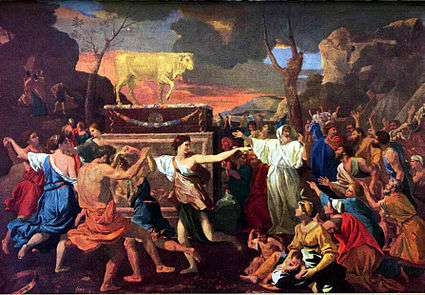Erev Rav
Erev Rav (Hebrew: עֵרֶב רַב erev rav 'mixed multitude') was a group that included Egyptians and others who had joined the Tribes of Israel on The Exodus.[1] According to Jewish tradition, they were accepted by Moses as an integral part of the people. Their influence is said to have been involved in the golden calf and other incidents where the people questioned Moses and his laws.

Etymology
According to contemporary Jewish Orthodox commentary Da'at Miqra, the words roughly correspond to the "mixed many", while Targum Onkelos translates it as "many foreigners". The term appears in Exodus 12:38: "A mixed crowd also went up with them, and livestock in great numbers, both flocks and herds" (NRSV). The "mixed crowd" is an English rendering of Erev Rav. While Exodus 12:38 is the only mention of the complete term Erev Rav in the entire Tanakh, the term Erev by itself (which also means evening in Hebrew),[2] also appears in Nehemiah 13:3, where it is used to refer to non-Jews.[3] Biblical scholar Shaul Bar has suggested that the term may have referred specifically to foreign mercenaries who intermarried with the Israelite people in Egypt.[3]
In modern Hebrew, it is used as an idiom for a mixture that exists outside of Judaism, especially in reference to non-Jews.
Jewish tradition
According to the Arizal, in every generation, the souls of the Erev Rav are reincarnated in numerous individuals.[4] The Zohar, which is the foundational text for Kabbalistic thought, says the Erev Rav not only exists in each generation, but it continues to be the cause for most of the problems affecting the Jewish people.[5] Currently, the term "Erev Rav" is used by Jews in a derogatory manner describing someone who is perceived as a traitor.[6]
See also
References
- T. Desmond Alexander; David W. Baker (13 January 2003). Dictionary of the Old Testament: Pentateuch: A Compendium of Contemporary Biblical Scholarship. InterVarsity Press. p. 456. ISBN 978-0-8308-1781-8.
- In Hebrew spelling without niqqud (vowel-points) the erev for evening and the erev for "mixed" are spelled identically. However, the first vowel in the two words is written and pronounced differently: evening has a segol, while mixed has a tzere.
- Bar, Shaul. "Who Were The Mixed Multitudes?" Hebrew Studies, vol. 49, 2008, pp. 27–39., (www.jstor.org/stable/27913875).
- Student, Gil (2002). Can The Rebbe Be Moshiach?: Proofs from Gemara, Midrash, and Rambam that the Rebbe zt"l cannot be Moshiach. Universal Publishers. p. 79. ISBN 1581126115.
- The initial letters of the words Rosh Bnei Yisrael (ראש בני ישראל, the heads of the Jewish people) spell ReBY ( רבי, teacher). This indicates that the Jews require a qualified teacher to transmit God’s message. The initial letters of the words Rasha'im Ba-choshekh Yidamu (רשעים בחשך ידמו, the wicked are cut off in darkness) (I Samuel 2: 9) also spell ReBY (רבי) (Likutey Moharan I, 111). In this case, it is a reference to unworthy people who wrest the leadership of the Jews from genuine teachers. These false leaders, who are referred to as the “mixed multitude,” will eventually be “cut off.” And then, the Zohar (III, 297b) teaches: “When the mixed multitude leaves the presence of the Jews, the verse ‘Count the heads of the Jewish people’ will be fulfilled”
- "What Is Erev Rav". Times of Israel. 11 February 2016.